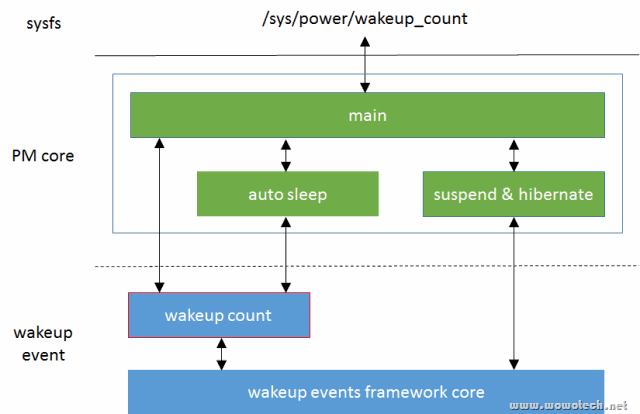Wakeup count功能
1 前言
Wakeup count是Wakeup events framework的组成部分,用于解决“system suspend和system wakeup events之间的同步问题”。本文将结合“Linux电源管理(6)_Generic PM之Suspend功能”和“Linux电源管理(7)_Wakeup events framework”两篇文章,分析wakeup count的功能、实现逻辑、背后的思考,同时也是对这两篇文章的复习和总结。
2 wakeup count在电源管理中的位置
wakeup count的实现位于wakeup events framework中(drivers/base/power/wakeup.c),主要为两个模块提供接口:通过PM core向用户空间提供sysfs接口;直接向autosleep(请参考下一篇文章)提供接口。

3 wakeup count的功能
wakeup count的功能是suspend同步,实现思路是这样的:
1)任何想发起电源状态切换的实体(可以是用户空间电源管理进程,也可以是内核线程,简称C),在发起状态切换前,读取系统的wakeup counts(该值记录了当前的wakeup event总数),并将读取的counts告知wakeup events framework。
2)wakeup events framework记录该counts到一个全局变量中(saved_count)。
3)随后C发起电源状态切换(如STR),执行suspend过程。
4)在suspend的过程中,wakeup events framework照旧工作(直到系统中断被关闭),上报wakeup events,增加wakeup events counts。
5)suspend执行的一些时间点(可参考“Linux电源管理(6)_Generic PM之Suspend功能”),会调用wakeup events framework提供的接口(pm_wakeup_pending),检查是否有wakeup没有处理。
6)检查逻辑很简单,就是比较当前的wakeup counts和saved wakeup counts(C发起电源状态切换时的counts),如果不同,就要终止suspend过程。
4 wakeup count的实现逻辑
4.1 一个例子
在进行代码分析之前,我们先用伪代码的形式,写出一个利用wakeup count进行suspend操作的例子,然后基于该例子,分析相关的实现。
1: do {
2: ret = read(&cnt, "/sys/power/wakeup_count");
3: if (ret) {
4: ret = write(cnt, "/sys/power/wakeup_count");
5: } else {
6: countine;
7: }
8: } while (!ret);
9:
10: write("mem", "/sys/power/state");
11:
12: /* goto here after wakeup */
例子很简单: a)读取wakeup count值,如果成功,将读取的值回写。否则说明有正在处理的wakeup events,continue。 b)回写后,判断返回值是否成功,如果不成功(说明读、写的过程中产生了wakeup events),继续读、写,直到成功。成功后,可以触发电源状态切换。
4.2 /sys/power/wakeup_count
wakeup_count文件是在kernel/power/main.c中,利用power_attr注册的,如下(大家可以仔细研读一下那一大段注释,内核很多注释写的非常好,而好的注释,就是软件功力的体现):
static ssize_t wakeup_count_show(struct kobject *kobj,
struct kobj_attribute *attr,
char *buf)
{
unsigned int val;
return pm_get_wakeup_count(&val, true) ?
sprintf(buf, "%u\n", val) : -EINTR;
}
static ssize_t wakeup_count_store(struct kobject *kobj,
struct kobj_attribute *attr,
const char *buf, size_t n)
{
unsigned int val;
int error;
error = pm_autosleep_lock();
if (error)
return error;
if (pm_autosleep_state() > PM_SUSPEND_ON) {
error = -EBUSY;
goto out;
}
error = -EINVAL;
if (sscanf(buf, "%u", &val) == 1) {
if (pm_save_wakeup_count(val))
error = n;
}
out:
pm_autosleep_unlock();
return error;
}
实现很简单:read时,直接调用pm_get_wakeup_count(注意第2个参数);write时,直接调用pm_save_wakeup_count(注意用户空间的wakeup count功能和auto sleep互斥,会在下篇文章解释原因)。这两个接口均是wakeup events framework提供的接口,跟着代码往下看吧。
4.3 pm_get_wakeup_count
pm_get_wakeup_count的实现如下:
bool pm_get_wakeup_count(unsigned int *count, bool block)
{
unsigned int cnt, inpr;
if (block) {
DEFINE_WAIT(wait);
for (;;) {
prepare_to_wait(&wakeup_count_wait_queue, &wait,
TASK_INTERRUPTIBLE);
split_counters(&cnt, &inpr);
if (inpr == 0 || signal_pending(current))
break;
schedule();
}
finish_wait(&wakeup_count_wait_queue, &wait);
}
split_counters(&cnt, &inpr);
*count = cnt;
return !inpr;
}
该接口有两个参数,一个是保存返回的count值得指针,另一个指示是否block,具体请参考代码逻辑:
a)如果block为false,直接读取registered wakeup events和wakeup events in progress两个counter值,将registered wakeup events交给第一个参数,并返回wakeup events in progress的状态(若返回false,说明当前有wakeup events正在处理,不适合suspend)。
b)如果block为true,定义一个等待队列,等待wakeup events in progress为0,再返回counter。
注1:由4.2小节可知,sysfs发起的read动作,block为true,所以如果有正在处理的wakeup events,read进程会阻塞。其它模块(如auto sleep)发起的read,则可能不需要阻塞。
4.4 pm_save_wakeup_count
pm_save_wakeup_count的实现如下:
bool pm_save_wakeup_count(unsigned int count)
{
unsigned int cnt, inpr;
unsigned long flags;
events_check_enabled = false;
spin_lock_irqsave(&events_lock, flags);
split_counters(&cnt, &inpr);
if (cnt == count && inpr == 0) {
saved_count = count;
events_check_enabled = true;
}
spin_unlock_irqrestore(&events_lock, flags);
return events_check_enabled;
}
- 1)注意这个变量,events_check_enabled,如果它不为真,pm_wakeup_pending接口直接返回false,意味着如果不利用wakeup count功能,suspend过程中不会做任何wakeup events检查,也就不会进行任何的同步。
- 2)解除当前的registered wakeup events、wakeup events in progress,保存在变量cnt和inpr中。
- 3)如果写入的值和cnt不同(说明读、写的过程中产生events),或者inpr不为零(说明有events正在被处理),返回false(说明此时不宜suspend)。
- 4)否则,events_check_enabled置位(后续的pm_wakeup_pending才会干活),返回true(可以suspend),并将当前的wakeup count保存在saved count变量中。
4.5 /sys/power/state
再回忆一下“Linux电源管理(6)_Generic PM之Suspend功能”中suspend的流程,在suspend_enter接口中,suspend前的最后一刻,会调用pm_wakeup_pending接口,代码如下:
static int suspend_enter(suspend_state_t state, bool *wakeup)
{
...
error = syscore_suspend();
if (!error) {
*wakeup = pm_wakeup_pending();
if (!(suspend_test(TEST_CORE) || *wakeup)) {
error = suspend_ops->enter(state);
events_check_enabled = false;
}
syscore_resume();
}
...
}
在write wakeup_count到调用pm_wakeup_pending这一段时间内,wakeup events framework会照常产生wakeup events,因此如果pending返回true,则不能“enter”,终止suspend吧!
注2:wakeup后,会清除events_check_enabled标记。
“Linux电源管理(7)_Wakeup events framework”中已经介绍过pm_wakeup_pending了,让我们再看一遍吧:
bool pm_wakeup_pending(void)
{
unsigned long flags;
bool ret = false;
spin_lock_irqsave(&events_lock, flags);
if (events_check_enabled) {
unsigned int cnt, inpr;
split_counters(&cnt, &inpr);
ret = (cnt != saved_count || inpr > 0);
events_check_enabled = !ret;
}
spin_unlock_irqrestore(&events_lock, flags);
if (ret)
print_active_wakeup_sources();
return ret;
}
a)首先会判断events_check_enabled是否有效,无效直接返回false。有效的话: b)获得cnt和inpr, 如果cnt不等于saved_count(说明这段时间内有events产生), 或者inpr不为0(说明有events正在被处理), 返回true(告诉调用者, 放弃吧, 时机不到)。同时清除events_check_enabled的状态。 c)否则, 返回false, 同时保持events_check_enabled的置位状态(以免pm_wakeup_pending再次调用)。
Okay,结束了,等待wakeup吧~~~~